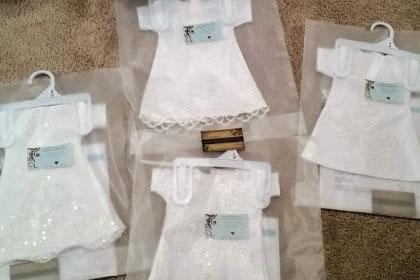
Memory gowns for babies.
Published: August 31, 2017
By: Emily Reed
Her name means “child of heaven,” “delicate” and “heavenly flower,” and at just six days old, weighing one pound and four ounces, Layah Faith Shelfer lost her chance at life.
“We had about two hours with her before we knew she was gone,” says Mika Shelfer, Layah’s mother. “She was born at 23 weeks, 17 weeks early, due to a then diagnosed incompetent cervix. We chose her middle name ‘Faith’ because we knew no matter the outcome, we had to have faith that His ways were better than ours. Layah had a massive pulmonary hemorrhage and they could not stop the bleeding.”
In the short time after Layah’s death, the Shelfer family was provided with a tiny pink dress for burial that fit Layah’s one-pound body.
“The last memory I have of Layah was the pink dress that fit her tiny body, and although my size five ring was too big on her tiny wrist, the dress’ lace around her wrist fit just perfectly,” Shelfer says. “It wasn’t all the bandages and tubes, but the dress. It was perfect, just like her, just too small for this earth. I don’t remember a lot of the details about that time, but that beautiful, tiny, gown is something that I remember quite vividly.”
Shelfer realized that numerous families face the loss of a baby, sometimes just hours or days old, and decided to begin Layah’s Ministry for Memory Gowns, re-purposing wedding gowns into burial gowns for babies. The organization became a 501c3 charity in January 2015, with a chapter in both Huntsville and Birmingham.
“Each memory gown is white or a variation of the color white because of the comparison to the bride of Christ and that these babies know no sin and are perfectly made in their mother’s womb,” Shelfer says. “I chose the name ‘memory gowns’ because it was the last thing I remember of Layah’s and as a bride, when a bride chooses her dress, it is ‘the one’ she picks in anticipation of her wedding day, full of hopes and dreams of her future.
“These families will not get to have memories with their children, and we want this one gown to be a small memory they might have that is pictured in their mind, or photographed that is priceless,” she explains. “Also, we want it to be a way that the donor can feel they are helping bless a family and do something good with a dress that otherwise may be left hanging in a closet, in all its beauty.”
The ministry has given out about 300 memory gowns, and Shelfer hopes to eventually expand the charity to reach most NICU units at hospitals throughout the state, and surrounding states.
“I would also love to offer financial support for those who choose to have a funeral,” Shelfer adds. “Our daughter was buried, and when you are totally caught off guard by this, the price is overwhelming when you are already walking in a numb state of shock at the loss of your child. I would love to work with funeral homes to help those families with that burden.”
The ministry relies on wedding dress donations that often come from California, Colorado, Texas, Tennessee, Georgia, and Alabama. Shelfer says the oldest wedding dress they received was from 1945, and the ministry was honored to use it. “We were not able to use the material because it had dry rot, but we were able to save one of the delicate flowers that was a hibiscus, and it was used for a memory gown.”
Currently, those interested meet once a month at Shelfer’s home in Alabaster, and work on the memory gowns. If a seamstress is unable to attend, some of the patterns and guidelines for the gowns can be mailed.
Shelfer says volunteers are needed for the ministry to serve in different capacities such as sewing, transporting gowns to hospitals throughout the state, and deconstructing wedding gowns. “Many times we need people to deconstruct and reconstruct the wedding dresses by taking the netting out with scissors or removing zippers and buttons,” Shelfer says. “You don’t have to be as delicate as you might think. We also sometimes just need someone to wash the wedding dresses, or to prepare them for being deconstructed.”
The ministry makes three sizes of memory gowns, and Shelfer says they often do not know if they are making a gown for a boy or a girl. “Statistically, more male micro-preemies die than girls, so we try to do more male gowns, but they are not as detailed, so it is a balance,” Shelfer says. “We also create buntings for those moms that miscarry a loss less than 20 weeks where they may not have a baby go to the NICU.”
In addition to volunteers, the ministry also seeks monetary donations to support the ability to mail gowns to families. “I am so privileged that God chose me to be Layah’s mom, and to use her life to help others that set out on this unexpected journey of grief to find His hope and true peace,” Shelfer says.
For more information about the ministry or to volunteer, contact Shelfer at (205) 936-3530 or visit Layah’s Ministry for Memory Gowns on Facebook.
Emily Reed is a freelance writer and stay-at-home mom to her son, Tobias.
